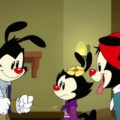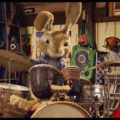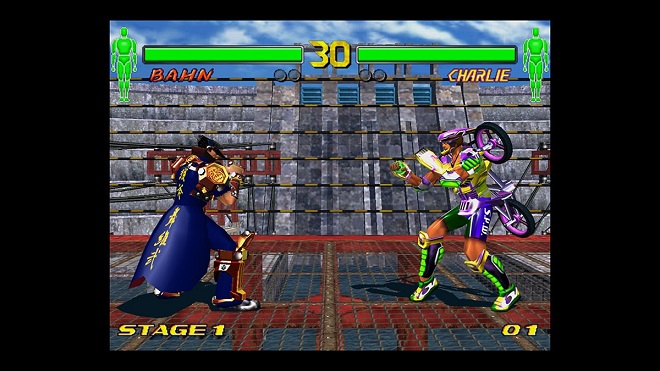Quarantine Control #180: Problem Boys from Mars

The current COVID-19 strain? Yup, it’s still not as big of a story as it should be. The media, in fairness to them, has plenty of other matters to cover, between the capture of a killer on the loose in Pennsylvania, wicked weather systems, and a potential sham impeachment of the current United States president. The new variant might be eradicated before it becomes too big of an issue, with the FDA approving of boosters for the current strain. It shouldn’t be long before they’re widely available in government-sanctioned medical establishments and drug stores. Fortunately, they’ll still be free.
Geoffrey Barnes
Zone of the Enders: The 2nd Runner — M∀RS (2018)
Source: PlayStation 4 (Originally in 2003 on PlayStation 2)
Episodes: 1 video game (that could have had a successor at one point)

FromSoftware’s Armored Core 6 is the new hotness as far as mech video games go, which could become the highest-selling installment in the franchise’s history. FromSoftware themselves has been on a roll of popularity since Demon’s Souls and Dark Souls released during the PlayStation 3 and Xbox 360 era, and their notoriety is only increasing with the likes of Sekiro: Shadows Die Twice and Elden Ring. It’s why the newest Armored Core game has been a hit among the gaming populace, despite previous installments only amounting to niche successes. I really want to play it, but currently can’t for financial reasons.
That’s why I went with the second-best game: Zone of the Enders: The 2nd Runner — M∀RS, the PS4 (and PC) remaster of the PS2 game from Konami and Kojima Productions at their height, this particular port commissioned by Cygames. I saw a recommendation for the game in July, during the marketing period for AC6, with a few gaming types recommending it if anyone needed a title to hold them off. I made sure to pick it up after the game went on sale. It delivered.
The 2nd Runner begins with protagonist Dingo Egret, a miner, falling into the cockpit of the Orbital Frame mech known as Jehuty. He has no choice but to fight back and keep himself save when attacked by the vicious BAHRAM forces who seek to seize Jehuty for themselves. He ultimately loses the fight after having no idea of how to control a weapon so dedicated to combat with its own AI, ADA. When Dingo refuses BAHRAM head Nohman’s offer to join him, he shoots him. Ken Marinaris, who seemed to be allied with Nohman but reveals herself to be part of the Space Force (well predating the real-life one), revives Dingo. But his body is now attached to Jehuty, meaning he’ll die if he leaves its cockpit. This is a great excuse to keep the player fighting in the mech throughout the entire experience.
Don’t take that as a complaint, though. The game throws plenty of challenges at the player in the fight between the Space Force and BAHRAM, and offers nonstop exhilaration. The game fortunately starts with a solid tutorial mode available from the menu and during the game, offering more than enough for a player to adjust to the controls. They’ll want to, because it only takes about an hour and a half before one requisite fight asks a specific question: “Do you seriously know how to play this game? Do you REALLY?” There are constant challenges throughout, some of which seem ridiculous from the start. But it never veers into the realm of unfairness. It simply forces the player to use the tools they’re given.
It throws out a lot of those tools too. There are basic controls where Jehuty can fire large energy balls, can attack with a saber, and dodge. These took enough time for me to adjust to, especially with the functions to move upward and downward being attached to buttons, and learning how to dash horizontally by moving the control stick and pressing two buttons simultaneously. Just when I adjusted to one subweapon, the game threw another one in my direction to play with. I won’t say I mastered them all, because the Gauntlet subweapon was too useful to give up thanks to its quick blast, armor-breaking properties, and low energy requirement. There are so many tools at the player’s disposal that the game forces you to think fast about the best ways to dispatch opposition. This is when the game is at its best, and why it leaves a memorable impact.
The little Kojima Productions touches are nice too. The mech designs are very similar to those from the Metal Gear Solid series, particularly Metal Gear Solid 2, to no surprise considering Yoji Shinkawa’s involvement as an art designer for both. The fonts and sound effects are also similar. But my favorite little touch involves Dingo having the option to provide little quips at comments from ADA and other characters provide during gameplay. He can give a sincere or a sarcastic response depending on whether the L3 or R3 buttons are pressed afterward. It’s the kind of feature that only a Kojima Productions team would think of.
Zone of the Enders: 2nd Runner feels like a PS2 game in some of the best ways, through offering a tightly-knit experience that isn’t too short but doesn’t overstay its welcome. That said, it also feels like a PS2 game in some of the worst ways. The cutscenes can’t be paused, in a commonality with the older MGS titles. This is something I learned the hard way at one point, though I’m glad there’s a cutscene viewer for catching up. The most unfortunate flaw is the localization, which Konami clearly didn’t want to spend too much money on. Several lines are written and translated awkwardly, and are performed by at least somewhat-talented voice actors with awkward reads and seemingly little voice direction. This makes for plenty of unintentionally hilarious moments, but I couldn’t stop thinking about how much better it could have been had Konami cared. That is, of course, a constant Konami problem.
None of those issues stop 2nd Runner from being great, though, an underappreciated gem for anyone who needed another mech game at this time. The game is, of course, also enjoyable outside that context. This all has me thinking about the canned Enders Project follow-up, one planned to be an alternate universe tale featuring Jehuty and Anubis that were more than just mechs. It was, well, ended for good once the old Kojima Productions was shuttered, and the current iteration is too busy to work on another mech game. If Cygames is interested in funding this kind of title, perhaps they could start their own IP, maybe even in collaboration with the current Kojima Productions. But it’s fortunate that 2nd Runner is still available, especially in so pristine a form.
Angela Moseley
I’ve been trying to get into my normal routine of writing again, especially when I return to work near the end of this month. I can’t say my efforts are quite keeping up with the schedule I set for myself. It turns out having a slight backlog of written material tends to stave off the urgency of a deadline. For example, I wrote this contribution about a week ago. The rough draft for the contribution I’m working on for next week isn’t done yet. Knowing me, I’m doubtful this backlog will last because of the temptation to fill that writing time with pure procrastination.
The Boys, season 2 (2020)
Source: Amazon Prime
Episodes: 8

If you’re an avid reader of this blog, you may have remembered that Geoff wrote about season 1 of The Boys for QC #127. In fact his closing words were,“This first season of The Boys was enough to hook me, and I will make watching the future seasons a priority… after I tackle some video games in the backlog. They should be there when I get back, though. It’s not like they’re on HBO Max.” Thankfully, this is still readily available on Amazon Prime. That said, I got to season 2 first and I needed something to write about, so here we are.
My experience with The Boys is a show that I’d been meaning to get to since I learned about its existence in 2020. A co-worker waltzed up to me and declared I should watch the show since I was geek. At first, I was taken aback by her words as I had no idea what the show was. Then I learned it was a world where the superheroes were assholes, not unlike The Watchmen (another series I need to see). While I wanted to see the show, each episode being an hour long was a bit of a turn-off. Still, it remained on my “to-do list” for three years. My surgery and subsequent six weeks off from work provided the perfect opportunity to finally check this show out. My husband and I ran through the first season over the course of two days. We took it a little slower on season 2 because how wild the twists were. When we finally did finish off the season on Labor Day, we were impressed.
Season 2 picks up immediately from the cliffhanger ending of season 1. Billy Butcher’s (Karl Urban) grand gambit to expose The Seven, and personally strike at Homelander (Anthony Starr) has failed spectacularly. He manages to get away, thanks to circumstances and leaves Hughie Campbell (Jack Quaid), Mother’s Milk (Laz Alonso), Frenchie (Tomer Capone), and Kimiko (Karen Fukuhara) on the run as fugitives. Worse, Vought under Stan Edgar’s (Giancarlo Esposito) leadership manages to weather the storm of information about Compound V leaking to the public. The corporation also introduces a more progressive face with a new hero, Stormfront (Aya Cash).
When Butcher finally returns to the group, he’s cut a deal with Grace Mallory (Laila Robins) and her connections in congress. There is a super terrorist that made his way into the area. No doubt Vought is involved somehow. Their mission is to capture this terrorist and turn him over to Mallory for a second chance to expose Vought’s wrong-doings. Problems arise when a few of the Supes at the corporation track them down, in addition to hunting the super terrorist themselves. It’s at this point where the fully disillusioned Starlight (Erin Moriarty) is forced to make a difficult choice, and Stormfront reveals she’s just as much of asshole as the other Supes.
This season of The Boys gave me a lot of anxiety because I wasn’t sure who was going to live, and who was going to die for the first few episodes. Considering the body count that season 1 ended on and season 2 started with, I don’t think my fears were unwarranted. Once things calmed down, I was able to enjoy the show for all the symbolism it showcased. Having a character like Stormfront was the perfect inclusion. If you keep up with politics, you’ve probably guessed that she’s not JUST named after a weather phenomenon, but also a very infamous message board. Her choice of costume, her hairstyle, and even her lightning powers are a deliberate allusion to what she is before the show makes an outright reveal.
Continuing with the excellent symbolism, it’s no surprise that Homelander and Stormfront eventually get along very well, despite him being put off by some of her obsessions. He not only is the evil Superman expy, but he represents the worst tendencies of America. Arrogance, pride, and a steadfast belief in being chosen by God to the point of having a superiority complex. It’s no accident that his cape is an American flag, and he spouts talking points reminiscent of the darkest depths of the “War on Terror.” Then combine these traits with a homicidal nature stacked on top of sociopathy, plus a need for public adoration. It’s no surprise that Homerlander’s issues meshes well with Stormfront’s own beliefs. Their machinations ultimately further Vought’s own, as long as profit and power can be maintained.
At some point in the series, the odds were stacked impossibly high for the boys. It felt like the villainous Supes would win the day, and our heroes, well, anti-heroes would be crushed. Amazingly, the fact that everyone is an asshole to a degree (maybe save for Hughie and Starlight), helps even the odds. Even when Hughie and Starlight can be their own worst enemies by being the nice ones in a world fulled with ruthless people. The amount of blackmail and backstabbing reaches almost ludicrous levels, but given everyone’s selfishness it’s pretty realistic. Deals are cut, reneged on, and the characters who have the slightest semblance of a consciousness become fed up with the status quo and find some morals. The last episode of the season ends on quite the cliffhanger, and sets up the next arc of the story nicely. After all, not all villainous Supes wear costumes.
If you’ve slept on The Boys, I highly recommend this deconstruction of the superhero genre– if you’re big on superheroes this show will likely appeal to you. It’s also a stunning look at America, the greed, the excess, and the disturbing shift to fascism. If you’ve already watched season 1, there’s no better time to get into season 2. I’ve already gotten started on season 3.
Joseph Daniels
Problem Children are Coming from Another World, aren’t they? (2013)
Source: Crunchyroll
Episodes: 10
Tigers?: Galdo Gaspar
Rabbits?: Black Rabbit

Have you noticed sometimes a character will make a bad first impression in order to make a better second impression? It’s supposed to show character growth and it can be an effective means of telling a story, but there are some cases where you kind of wish they’d made a good first impression in the first place.
This trope is most effective when used in a movie, since you get the emotional payoff right away and don’t have to wait to see if he or she gets better. If you must use it in a television show, it’s probably best to have the character growth happen early, otherwise you may start to attract a fanbase of all the wrong people, and then risk alienating those wrong people when the main character starts to realize his behaviour is wrong. You also run the risk of alienating the people who would better appreciate what the character becomes by showing them too much of what the character starts out as. You might be able to get away with it in an ensemble cast, like in Lost or Heroes, but unless you have at least some likeable or compelling characters from the start, it doesn’t matter that they improve later, you’re going to lose a lot of your audience because they won’t want to wait and see what you have in store for them.
In the case of Problem Children, Izayoi is arrogant and acts a bit like an edgelord in his first few minutes of screen time. In episode one, Izayoi declares how bored he is with things and when he’s summoned to another world, the first thing he does is seek out a god to challenge, whom he wins easily against with overpowered skills.
It’s in episode two where he learns why he was summoned and agrees to help, and actually starts to sound like a reasonable person. He’s still overpowered and he’s also got a genius intellect, but he doesn’t seem to lord it over everyone else. As arrogant as he is, he knows enough to behave himself when around others.
After watching the first episode, I came away feeling like the series doesn’t take itself seriously. I don’t quite know how to describe how it’s different from the typical anime I see on Crunchyroll today, but it feels like a breath of fresh air. This could be because it’s an anime from ten years ago, when there were different trends to chase. It’s an isekai anime, too, made at a time when isekai wasn’t the dime a dozen genre it is now, and also at a time when more isekai protagonists had a choice in the matter. The main premise is that three youngsters receive and accept invitations to go to another world (rather than just being pulled out of their lives through death or involuntary summoning) and when there, they pledge to help a community that had its name taken away, and vow to take down the world’s Demon Lords in the process. The other world is called Little Garden, and people use their supernatural powers in games designed to bestow prestige and wealth to the communities who win.
Along with Izayoi, the other two characters summoned are Asuka and You (“Yō” on Wikipedia, “You” in Crunchyroll’s subtitles), and of the two, I wish I got to see more of You’s powers. She inherits the power of any animal she can consider a friend. This alone would be an awesome anime for me to watch, a girl communicating with and befriending animals gradually over the course of the series and then using that power to help others. This is why Cardcaptor Sakura is such a pleasure to watch. Sakura has to recapture every card, and the series does not just gloss over this journey of hers. She uses what cards she does have to gradually get back the other cards and you’re right there with her, watching her fill out her deck. This is the biggest problem I have with Problem Children. In order to pace its story as rapidly as it does, we don’t get to see You’s journey to befriend animals. We do actually see her challenge and befriend a griffin, but episode seven has her use the power of the elephant and a throwaway line suggests that she befriended an elephant at some point during her time in Little Garden. Basically, the show’s characters are sidelined in order to tell its story, and that’s a crying shame.
It isn’t just the characters that we lose out on. The world of Little Garden only gets a little less than ten episodes to show itself off and that’s far too few episodes for a world this fascinating. It’s chock full of many different races of non-humans and half-humans, including many that are part animal. Black Rabbit is pretty much the main character among the animal-like characters, but you see them everywhere in the background. There’s also a character among the supporting cast with fox ears and two fox tails which I also wish we got to see more of.
I think that’s the main reason I feel cheated by this anime. The stuff I wanted to see more of (You, Little Garden and the various races that live there) aren’t shown enough and don’t seem to matter to the story as much as I wish they were. It’s still a fun anime to watch and I don’t regret watching it, but if these elements matter to you, you probably will also come away feeling like you were only served half of a pizza when you’re fairly certain you wanted the entire thing.
The anime is based on a series of light novels which seem to still be ongoing to this day, so there’s plenty of material there if they had wanted to make more than ten episodes or even just a second season. It’s been ten years, though, and the chances of any more episodes are slim, since I don’t get the impression that it’s a very popular series. Ideally, I would want to see an adaptation that runs for a lot more than ten episodes, considering the show that I’m going to cover next week had a much longer first season and then got a second season which is currently airing and which is going to go on its midseason hiatus fairly soon. Next week, I’m also planning on assembling a few examples of characters who have a laundry list of defects but who end up being heroic anyway, in order to expand on my thesis statement from this week and let’s just say it’s going to be a very long article.
This Week’s Short Film
The Mysterious Amulet (2023)
https://www.youtube.com/watch?v=w6rcM7Pt4nc
The summer season is winding down in some western territories, but our climate change hell will smolder with us forever. Not to mention all the other issues that would draw out this conclusion for far too long. Until next week.





